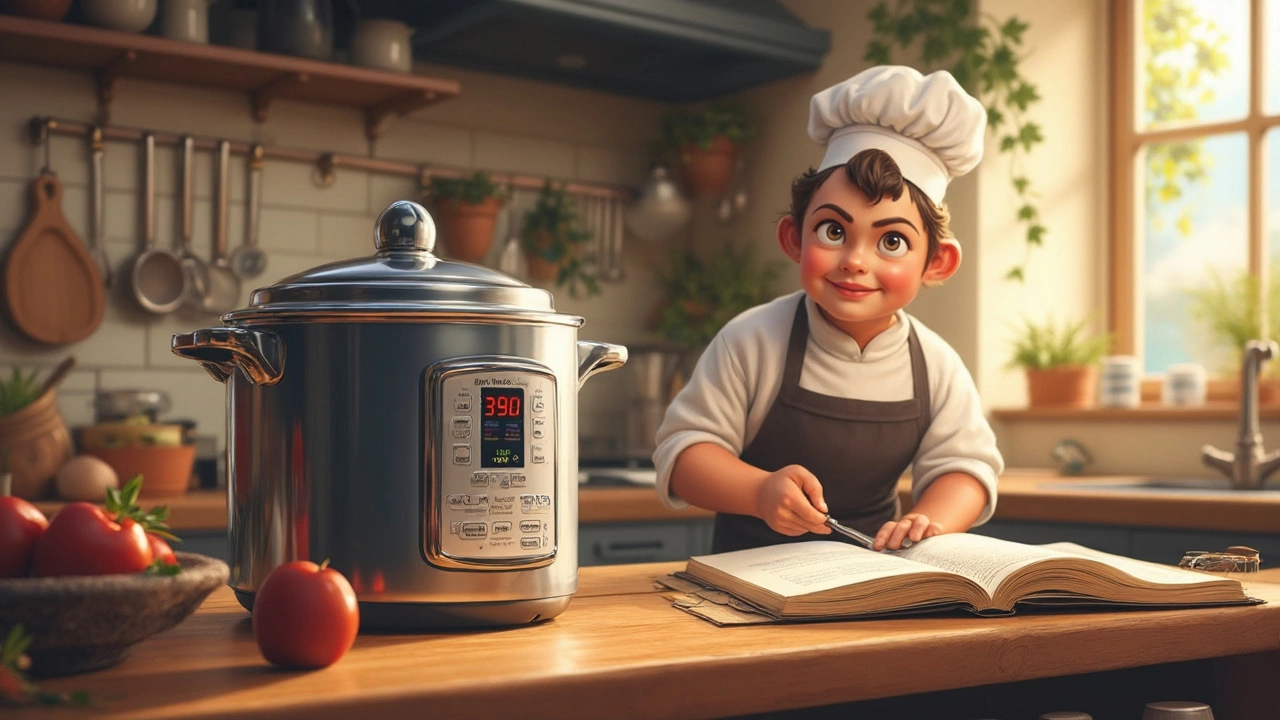Ever had your dinner plans dashed by a tricky pressure cooker? You're not alone! These gadgets are kitchen heroes when they work, but understanding their quirks helps you go from frustration to fixed in no time.
One of the most common hiccups is steam leaking where it shouldn't. Usually, this is due to faulty sealing rings. A sealing ring that's past its prime won't create an airtight seal, letting precious steam escape and your meal expectations deflate.
If steam's not the issue, maybe it's your cooker just not building up pressure. This might be down to a sneaky blockage in the vent pipe. A quick check and clean might get things flowing smoothly again. Remember, regular upkeep is key to keeping these kitchen workhorses running like clockwork.
- Understanding Pressure Cooker Basics
- Leaking Steam Issues
- Pressure Not Building Up
- Lid Problems
- Safety Valve Malfunctions
- Regular Maintenance Tips
Understanding Pressure Cooker Basics
Pressure cookers might look a bit intimidating at first glance, but they're not rocket science. Think of your pressure cooker as a sealed pot with a valve that controls the steam pressure inside. When you heat the cooker, the pressure builds up, raising the temperature and cooking food faster. It's all about steam pressure doing the heavy lifting for you.
Modern pressure cookers come with all sorts of bells and whistles, making them safer and easier to use than the ones our grandparents used. You’ll often find electric cookers with digital displays and safety features like automatic pressure release.
Anatomy of a Pressure Cooker
A quick tour around the pressure cooker might help:
- Lid: Most important part. It locks in place to create the seal needed for pressure cooking.
- Sealing Ring: This is usually a rubber or silicone gasket found inside the lid and is crucial for maintaining pressure. Inspect it regularly for wear and tear.
- Pressure Valve: Acts as the steam-release station. Adjusts pressure as needed or releases steam when cooking is done.
Why Pressure Cookers Are Your Kitchen's Best Friend
The big draw of a pressure cooker? Speed. Foods that usually take hours can be done in a fraction of the time, making it perfect for busy folks. Plus, the sealed environment retains more nutrients than other cooking methods.
Once you get the basics down, those kitchen concerns will start to seem less like problems and more like part of the cooking adventure. And hey, with the right know-how, your cooker could save you loads of time even on the busiest weeknights!
Leaking Steam Issues
Dealing with leaking steam can be a real bummer when you're hungry and ready for dinner. This is probably the most common issue pressure cooker users run into. But fear not! It's usually something you can fix with just a little effort.
Check the Sealing Ring
The sealing ring, a rubber or silicone gasket, is crucial for maintaining pressure in your cooker. Over time, it can wear out or become damaged, leading to pesky steam leaks. Inspect it regularly and replace it at least once a year as routine maintenance. Always have a spare on hand; it can be a lifesaver!
Look at the Lid
If the sealing ring seems fine, the lid itself could be the issue. It has to be closed correctly to create a seal. Even a small misalignment can cause steam to escape. Make sure you place it properly each time.
Address Blocked Vents
Blocked vents can lead to steam escaping from the sides. It's often due to food residue. Ensure the vent pipe is clean and clear. Regular cleaning just adds a few minutes to your cooker cleanup routine but makes a big difference.
"A well-maintained pressure cooker is as safe as a modern automobile," says Laura Pazzaglia, author of the Hip Pressure Cooking blog, emphasizing the importance of routine checks.
Replacement and Maintenance Tips
- Examine the sealing ring for cracks or deformations.
- Wipe down the lid edges and ensure the locking mechanism works smoothly.
- Routinely clean the vent pipe to prevent blockages.
- Replace the sealing ring yearly for optimal performance.
These checks take just a few minutes but can save you from bigger headaches down the line. Here’s a quick stat: kitchens with well-maintained pressure cookers report about 50% fewer issues related to steam leaks.
| Maintenance Task | Frequency |
|---|---|
| Inspect Sealing Ring | Monthly |
| Clean Vent Pipe | After Every Use |
| Replace Sealing Ring | Annually |
So, addressing these common areas can turn your pressure cooker from a steam-spitting menace back into your kitchen sidekick.
Pressure Not Building Up
So, your pressure cooker isn't building up pressure? That's a real kitchen bummer, but let's troubleshoot this together.
Check the Gasket
The gasket or the sealing ring is the rubbery band that fits into the lid. Over time, it can wear and lose its elasticity. This is like trying to make a good sandwich without bread—it just won't work! Make sure the gasket is seated correctly and isn't cracked or damaged.
Inspect the Vent Pipe
Blocked vent pipes are another common snag. This happens when food particles sneak into the pipe and build a blockade like an unwanted toll booth. Grab a pipe cleaner or a toothpick to gently clear out these tricky traps.
"A blocked vent is like having a closed chimney in an operational fireplace – it’s bound to cause issues," advises Susan Miller, a renowned kitchen appliance expert.
Water Levels Matter
Too little or too much water can mess with building pressure. Your pressure cooker needs the right amount to generate steam, so check your recipe's liquid requirements.
Check the Lid Alignment
Believe it or not, a wonky lid alignment can sabotage your pressure cooker’s performance. Double-check that the lid is locked and sealed correctly before cranking up the heat.
sticking to these basic checks can save you a lot of time and keep your culinary adventures on track. Remember, regular maintenance is your best friend when it comes to these kitchen warriors!

Lid Problems
The lid is like a key to your pressure cooker's kingdom. If it’s not fitting right or you're having trouble locking it, you might feel like you're in a culinary standstill. Let’s dive into some practical solutions.
Improper Closure
One of the main culprits here is grime buildup. Check the lid for food particles or other debris lurking around the edges. A quick clean with warm, soapy water usually does the trick. Scrub gently, and don’t forget the nooks and crannies around the sealing ring.
Swollen Sealing Ring
Over time, the sealing ring can swell or warp, making it hard for the lid to close securely. If your ring doesn’t snap into place, it’s probably time for a replacement. As a general rule of thumb, aim to replace the ring every 12 to 18 months.
Lid Stuck
If the lid won’t open after cooking, try allowing the pressure cooker to cool naturally. Rapid cooling isn't its forte and can cause vacuum seal issues. Patience can save you a lot of frayed nerves here.
Lock Indicator Malfunction
Some cookers have a lock indicator that lets you know when it’s safe to open the lid. If this indicator isn't working properly, it may just need a light cleaning or realignment. However, this might also indicate a worn-out component needing professional assistance.
| Lid Problem | Possible Fix |
|---|---|
| Improper Closure | Clean edges; check for debris |
| Swollen Sealing Ring | Replace ring |
| Lid Stuck | Allow natural cooling |
| Lock Indicator Malfunction | Clean or realign indicator |
Addressing these common cooker repair issues will help ensure your favorite kitchen tool is ready whenever you need it, especially when you're counting on it for those last-minute meals!
Safety Valve Malfunctions
If there's one thing that keeps your meal from turning into a splashy, kitchen disaster, it's the safety valve on your trusty pressure cooker. It's like the unsung hero, making sure everything stays calm and collected. But when it malfunctions, it can be a bit nerve-wracking.
Why Safety Valves Matter
The safety valve is basically your cooker’s pressure gatekeeper. Its job is to release excess pressure when things start heating up too much. If it’s not working right, you might end up with undercooked food or, worse, a pressure build-up that could be risky.
Common Signs of Valve Issues
If you notice steam escaping constantly or a scary rattling, it might be a sign that the safety valve is acting up. Sometimes, a simple clean might do the trick. But if it seems a bit more serious, think about replacing the valve for peace of mind.
Quick Fixes and Checks
- Inspect and Clean: Check the valve for any bits of food stuck, as these could be blocking it. A clean valve is a happy valve!
- Test the Valve: Push it lightly to see if it moves freely. It should return to its position by itself.
- Replacement Time: If it’s giving you too much trouble, consider getting a replacement safety valve specific to your cooker model.
When to Call a Pro
Most of the time, you'll feel like a pro after dealing with these common problems. But sometimes, it's better to call in the experts, especially if the cooker is pretty old or the valve refuses to behave no matter what you do.
Statistics on Pressure Cooker Issues
| Issue | Percentage of Users |
|---|---|
| Valve Blockages | 25% |
| Steam Leaks | 40% |
| Lid Malfunctions | 15% |
Keeping an eye on your pressure cooker and handling these small glitches early on saves time and keeps your kitchen adventures safe and enjoyable.
Regular Maintenance Tips
Keeping your pressure cooker in tip-top shape might seem like a chore, but it's a small price for hassle-free meal prep. Here’s how you can stay ahead of any cooker catastrophe:
Keep the Sealing Ring Happy
The sealing ring is like the lifeline of your cooker. It needs to be flexible and clean to work properly. Make it a habit to inspect this ring for any deformations or cracks. If it feels brittle or worn out, it's time to replace it. Otherwise, you might find yourself with leaks or undercooked food.
Clear the Vents
Vents can get clogged pretty easily, and when that happens, pressure doesn't build up well. Give the vents a routine cleaning with a toothpick or a small brush. Keeping them clear ensures your meals cook evenly and efficiently.
Check the Safety Valve
Don’t ignore the safety valve; it’s what keeps the pressure from building up too much. Ensure it's functional and clean it regularly. If it seems faulty, replacing it is better than risking it.
Regular Cleaning
Sometimes, food residues can stick to the sides and the bottom. A thorough cleaning with warm, soapy water after each use prevents these residues from building up. For tough spots, a bit of baking soda can help!
Storage Smarts
- Store the cooker with the lid upside down to let any moisture escape.
- Keep the sealing ring out of extreme temperatures as they can make it age faster.
- Consider taking the sealing ring out while not in use to prolong its lifespan.
By following these steps, you'll extend the life of your cooker and save yourself from unexpected repairs. A little maintenance goes a long way in making your cooker a reliable kitchen companion.


